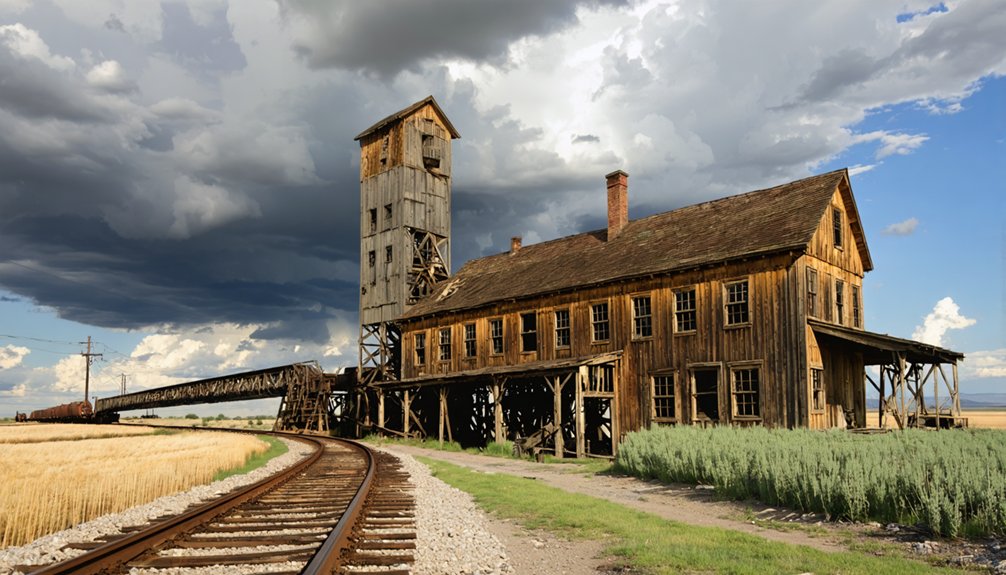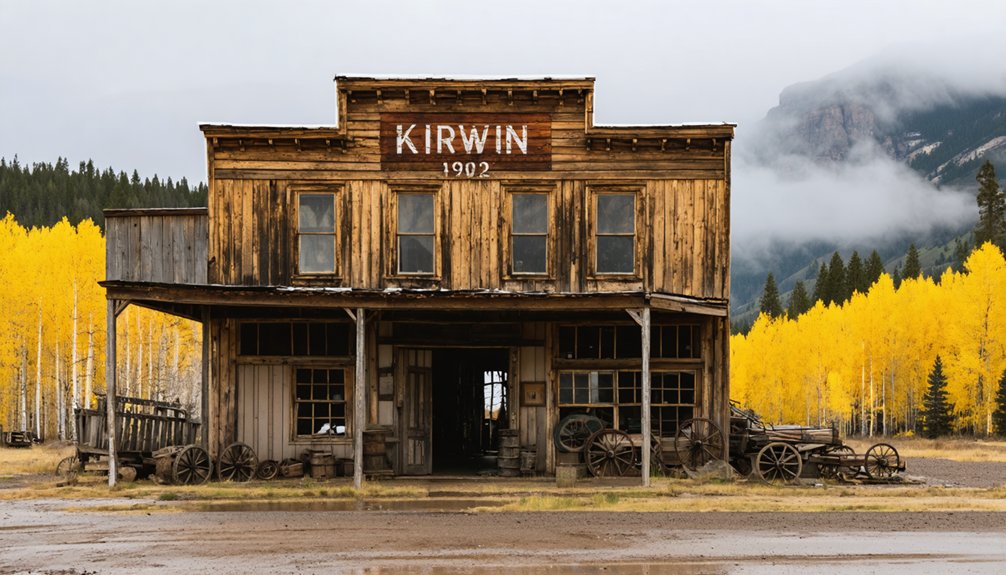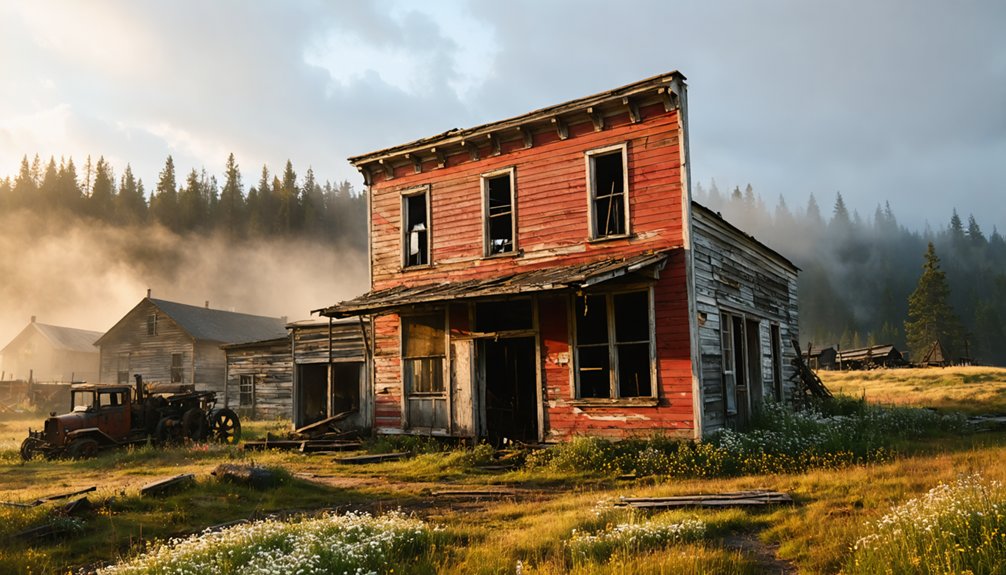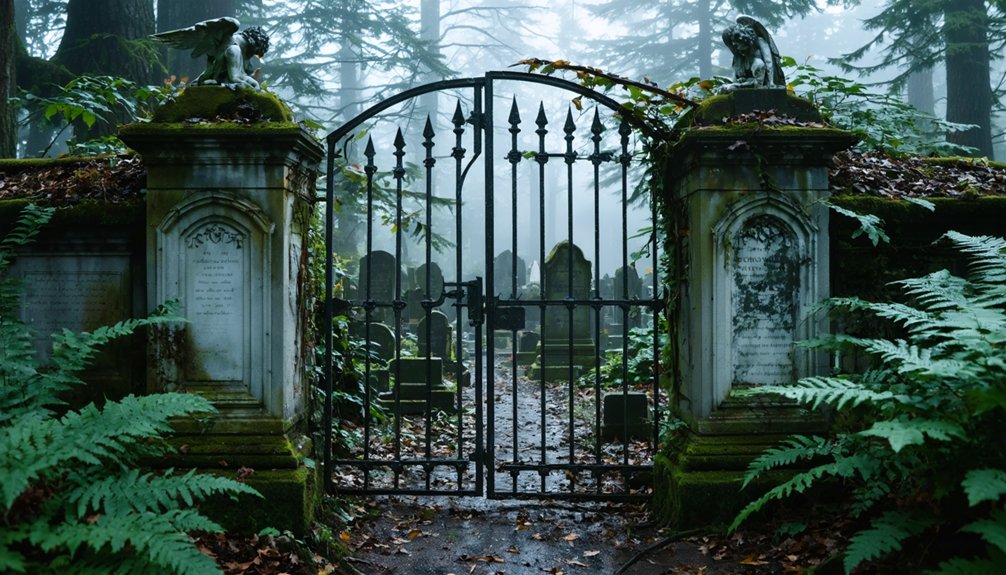You’ll discover haunting remnants of pioneer dreams along the Columbia River, from Vanport’s tragic 1948 flood to Shaniko’s glory days as the “Wool Capital of the World.” These ghost towns tell tales of boom-and-bust cycles, including Rufus’s bustling telegraph hub and Galena’s silver mining heritage. While some communities like Condon evolved into living museums, others vanished beneath dam waters or simply faded away. Each abandoned settlement holds untold stories of triumph and loss in the American West.
Key Takeaways
- Vanport, once Oregon’s second-largest city with 40,000 residents, was completely destroyed by flooding in 1948 and never rebuilt.
- Shaniko transformed from the “Wool Capital of the World” with 600 residents to a ghost town of 20-30 people today.
- Kettle Falls and Marcus now lie underwater, submerged when the Grand Coulee Dam created Lake Roosevelt.
- Ainsworth, a major railroad town housing thousands of Chinese laborers, vanished after the completion of its railroad bridge.
- Rufus began as a significant trading post and telegraph hub in 1886, supporting river trade through locally-built steamboats.
The Rise and Fall of Vanport: Oregon’s Lost City
Wartime urgency birthed Vanport, a remarkable city that rose from marshy Columbia River bottomlands in just 110 days.
You’d find yourself in Oregon’s second-largest city, where 40,000 residents created a vibrant, multicultural community unlike anything the state had seen before. As Kaiser Shipyard workers poured in, this “glorified auto camp” became home to countless families seeking opportunity.
The city’s schools made history as the first in Oregon to hire Black teachers.
The community showcased unprecedented diversity with one-third black residents living and working alongside people of various ethnicities.
But Vanport’s story ended tragically on Memorial Day 1948, when floodwaters breached the dikes and swept the city away in mere hours.
While official records claim 15 lives lost, Vanport memories tell a different tale.
Today, as you walk through Delta Park or the Portland International Raceway, you’re treading on a powerful community legacy that forever changed Portland’s social fabric through its brief but transformative existence.
Shaniko: From Wool Capital to Western Time Capsule
While Vanport’s dramatic flood marked one Columbia River community’s end, another Oregon town’s story unfolded in the high desert plateau to the east.
You’ll find Shaniko’s tale woven into the fabric of America’s wool heritage, where this remote outpost once earned the title “Wool Capital of the World.” In 1905, you could’ve witnessed $5 million in wool profits flow through its bustling streets, as the Columbia Southern Railroad carried millions of pounds of precious cargo to distant markets. Two devastating fires in 1910-1911 accelerated the town’s transformation, destroying significant portions of its business district.
Today, you’re walking through a living museum where only 20-30 residents remain. The peak population of 600 marked the town’s heyday before a new rail line bypassed it in 1911, leading to its gradual decline. The wooden sidewalks and historic buildings tell stories of boom-and-bust, while the Preservation Guild keeps Shaniko’s spirit alive.
A time capsule frozen in wooden planks and pioneer dreams, where a handful of souls guard Shaniko’s fading echoes.
This beloved ghost town draws hundreds each August, proving that freedom-seeking adventurers still find magic in its weathered facades.
Trading Posts and Telegraph Lines: The Story of Rufus
As steamboat whistles pierced the Columbia River air in 1886, Rufus Carroll Wallis established more than just a post office – he laid the foundation for a significant trading empire.
At its peak, you’d have found a bustling hub where telegraph communications kept the wheels of commerce turning, connecting wheat farmers to distant markets and coordinating ferry crossings across the mighty Columbia. The town’s namesake, Rufus Carroll Wallis, operated on both sides of the river with thriving business ventures. The sheer volume of trade was supported by the river’s mean flow exceeding 300,000 cubic feet per second, allowing for robust maritime commerce.
Here’s what made Rufus a powerhouse of its time:
- Agricultural businesses thrived with Pacific Coast Elevator Company and Farmers Co-op anchoring the local economy.
- Two locally-built steamboats, the Yukon and Columbia, connected the town to river trade.
- Essential services including hotels, saloons, and carriage yards served travelers and traders alike.
Though quieter today, Rufus’s legacy as a fundamental 19th-century trading post lives on in Sherman County’s history.
Gold Rush Dreams: Exploring Galena’s Mining Legacy
You’ll still find the rusting remnants of stamp mills and mining equipment scattered across Galena’s abandoned grounds, silent witnesses to the region’s prosperous mining era.
The town’s dramatic transformation from a bustling mining settlement into a ghost town mirrors the familiar boom-to-bust pattern that defined many Columbia River communities during the late 19th and early 20th centuries.
Walking through Galena today, you’re surrounded by weathered structures and mechanical artifacts that tell the story of ambitious prospectors who once extracted silver, lead, zinc, copper, and gold from the area’s rich mineral veins.
Like many instant cities and boomtowns throughout the Columbia River Basin, Galena’s population swelled rapidly after mineral discoveries but declined just as swiftly once the resources were depleted.
Similar to Bodie, California’s preservation efforts, the site has become a living history museum, allowing visitors to experience firsthand the remnants of the American mining frontier.
Mining Equipment Remains Today
The rusted remnants of Galena Mine’s industrial past tell a compelling story of innovation and persistence in the Columbia River region.
Like many gold rush sites, the area holds significant historical value that must be preserved and respected according to federal law.
As you explore the site today, you’ll find archaeological features that showcase the scale of mining operations that once thrived here.
Mining machinery remains, from massive mill foundations to equipment mounting pads, offer glimpses into the industrial heritage that shaped this landscape.
The historic mine continues its legacy as one of the region’s most prolific silver producers.
- Load Haul Dump vehicles and haul trucks, though long silent, left their mark through preserved maintenance areas and equipment yards.
- Cable systems that once transported ore down hillsides can still be traced through surviving support structures.
- Mill sites reveal the bones of ore processing operations, with foundation bolts and bins standing as evidence to the region’s mining ambitions.
Boom-To-Bust Mining Settlement
When gold fever swept through the Columbia River region in the late 1800s, Galena emerged as one of the most promising polymetallic mining settlements in Ferry County, Washington.
You’d have witnessed the rapid transformation of a simple mining camp into a bustling frontier town, complete with schools, hotels, and essential supply depots.
The mining challenges were formidable, yet the promise of striking it rich kept settlers pouring in.
With ore containing up to 90 percent galena and significant gold and silver deposits, community survival hinged on extracting these precious resources.
You’ll find that Galena’s story mirrors countless other mining settlements – a tale of dramatic rises and falls, where steam-powered mills churned day and night, and diverse groups of miners, merchants, and families carved out lives amid the rugged landscape.
Condon’s Journey From Boom to Living History

Nestled among the rolling wheat fields of north-central Oregon, Condon’s transformation from a bustling frontier settlement to a living museum spans nearly 150 years of American West history.
Unlike many Columbia River towns that faded into obscurity, Condon’s agricultural legacy and historic preservation efforts have kept its pioneer spirit alive.
- You’ll find Main Street’s preserved architecture listed on the National Register of Historic Places.
- You can explore the museum complex featuring an authentic 1905 railroad depot and turn-of-the-century schoolhouse.
- You’ll discover connections to notable figures like Nobel laureate Linus Pauling and geologist Thomas Condon.
From its humble beginnings as Summit Springs to its current status as a vibrant rural community, Condon stands as a symbol of the endurance of small-town America, where wheat still grows and history lives on through carefully maintained buildings and cherished local stories.
Hidden Homesteads Along the Columbia River
You’ll find weathered log cabins and forgotten homesteads dotting the Columbia River’s shoreline, where pioneers like Lewis Anderson and Joseph Diver carved out their lives from the wilderness in the mid-to-late 1800s.
These hidden homes, from the Anderson Homestead’s hand-hewn logs to the mysterious Freedom Home’s secret rooms, tell stories of both triumph and hardship along the river’s edge.
While many of these structures succumbed to dam projects, economic shifts, and time itself, their remaining foundations and walls stand as silent witnesses to the determination of early settlers who shaped the region’s character.
Pioneer Life and Loss
Throughout the rugged terrain of the Columbia River Gorge, traces of pioneer life remain hidden beneath decades of overgrowth and shifting landscapes.
You’ll find evidence of pioneer resilience in abandoned homesteads that once thrived along these fertile banks, where early settlers battled harsh conditions while developing agricultural innovations like irrigation systems as early as 1859.
These determined pioneers faced:
- Daily struggles with unpredictable river conditions and isolation, relying on crude ferries for essential transportation
- Constant challenges securing food supplies before their farms could sustain them, often trading with Native peoples
- The eventual loss of their communities to economic hardship, with many homesteads succumbing to nature or submerged beneath dam waters
Today, these ghost towns stand as silent testimonies to the freedom-seeking spirit that drove settlers to forge new lives along the Columbia’s shores.
Weathered Buildings Still Standing
Standing in defiance of time and nature, weathered buildings from the mid-19th century still dot the Columbia River’s landscape, from the iconic Goodnoe Hill Schoolhouse with its aging bell tower to abandoned homesteads hidden beneath decades of forest growth.
You’ll find these weathered architecture treasures tucked away on dead-end roads and overgrown paths – former homes, hotels, and mills that tell stories of pioneer ambition and eventual exodus.
While wooden structures show their age through collapsed roofs and splintered walls, military installations like Battery 247 stand firm in their concrete resilience.
The region’s historical preservation exists largely through natural decay, with many buildings left untouched since their abandonment.
If you venture off the main highways, you’ll discover these silent sentinels of the past, their weather-beaten frames still showcasing the craftsmanship of early settlers.
River’s Edge Settlement Stories
Beyond these weathered buildings lie deeper stories of the Columbia River’s early inhabitants, whose homesteads carved out pockets of civilization along its winding banks.
You’ll find traces of both triumph and hardship in these riverside settlements, where pioneers and indigenous peoples once shared the landscape. The river’s edge wasn’t just a boundary – it was the lifeline that sustained communities through riverbank agriculture and indigenous fishing traditions stretching back thousands of years.
- Family homesteads often clustered near traditional Native fishing grounds, creating complex cultural intersections where both communities relied on the river’s bounty.
- Self-sufficient settlers built and sometimes relocated entire structures, adapting to the river’s changing moods.
- Many settlements began as hopeful ventures but succumbed to harsh conditions, leaving only memories and weathered foundations behind.
Flood Waters and Forgotten Communities
Along the Columbia River’s winding path, the construction of the Grand Coulee Dam forever changed the landscape, submerging eleven thriving communities beneath Lake Roosevelt’s waters.
You’ll find flooded histories in towns like Kettle Falls and Marcus, where entire neighborhoods now rest silently underwater. The submerged legacies of these communities tell stories of displacement and loss.
Perhaps the most dramatic tale belongs to Vanport, Oregon’s second-largest city, which vanished in 1948 when floodwaters breached a dike, displacing 18,500 residents in less than two hours.
In mere hours, Vanport transformed from Oregon’s bustling second city into a watery ghost town, claiming thousands of displaced lives.
The disaster left an indelible mark on the Pacific Northwest, particularly affecting the African American community who called Vanport home.
While some towns were relocated, others like Peach and Jerome remain permanently lost, their memories preserved only in photographs and oral histories.
Railroad Towns That Time Left Behind

When railroads carved their paths through the Pacific Northwest in the late 1800s, they birthed dozens of bustling communities along the Columbia River’s shores.
You’ll find their weathered remains scattered across the landscape, proof to an era when railroad expansion transformed wilderness into thriving settlements.
- Ainsworth rose and fell with stunning speed, hosting thousands of Chinese laborers and producing 80,000 feet of lumber daily before vanishing when the railroad bridge was completed.
- Shaniko’s reign as the world’s wool shipping capital ended abruptly when new rail routes bypassed the town.
- Friend and Boyd flourished as crucial trading posts until the Great Southern Railroad’s removal sealed their fate.
These ghost towns remind you how quickly fortunes can change – their economic decline marking the end of an era when rails ruled the region.
Preserving the Past: Ghost Town Architecture
The silent architecture of Columbia River ghost towns tells stories as compelling as the communities that once thrived there.
You’ll find wooden frame buildings with clapboard siding and gabled roofs standing as proof to 19th-century frontier life, while false-fronted commercial structures and sturdy churches hint at bustling Main Streets of yesteryear.
Ghost town preservation efforts face constant challenges from weather and vandalism, but dedicated historical societies and volunteers work tirelessly to maintain architectural integrity.
You can explore restored post offices, schoolhouses, and mills that now serve as museums and visitor centers.
Local partnerships guarantee these treasures receive protection through National Register listings and preservation grants, while tourism helps fund ongoing restoration work.
Through these efforts, you’re free to step back in time and experience authentic pieces of Pacific Northwest history.
Following the Pioneer Trail: Lost Settlement Sites

As you travel along the historic pioneer trails of the Columbia River Gorge, you’ll encounter the scattered remains of once-thriving settlements like Rufus and Franklin, which served as crucial waypoints for westward-bound travelers.
These lost communities, strategically positioned near river crossings and along stagecoach routes, tell the story of the region’s earliest transportation networks through their surviving structures and foundation stones.
Your journey through these forgotten places reveals how pioneer-era settlements transformed from simple supply stops into bustling hubs of commerce before ultimately succumbing to changing times and the harsh realities of frontier life.
Pioneer Routes and Settlements
Pioneering settlers who ventured westward in the mid-1800s discovered the Columbia River corridor offered a significant yet treacherous pathway to new opportunities.
The complex pioneer infrastructure required careful navigation of natural obstacles, with Indigenous trails and portage routes becoming lifelines for your westward journey. Settlement dynamics shaped communities around essential transportation hubs, particularly near Fort Vancouver and The Dalles.
You’ll find remnants of this remarkable era in:
- Ghost towns like Goodnoe and Franklin, where cattle posts and trading outposts once thrived
- Former settlement sites near the Cascades Rapids, where early pioneers established significant portage operations
- Abandoned communities that sprung up around railroad intersections, their remains telling tales of boom-and-bust cycles
These forgotten places stand as silent witnesses to the determination of those who sought freedom in the American West.
Remnants of Early Communities
While exploring the Columbia River’s historic corridor today, you’ll discover poignant remnants of once-thriving pioneer communities scattered across the landscape. You can still find weathered schoolhouses, abandoned barns, and rusted machinery that tell the story of these settlement artifacts.
The Goodnoe Schoolhouse stands as one of the most visible community legacies, offering a glimpse into frontier education and daily life.
Throughout Franklin, Rufus, and Goodnoe Hill, you’ll encounter foundations of homes, stores, and community buildings that once formed bustling settlements. These sites hold tangible connections to the past through preserved structures and equipment, though nature steadily reclaims them.
While many locations remain accessible, they’re vulnerable to vandalism and decay, serving as stark reminders of the region’s pioneering spirit.
Transportation Hub Locations
The Columbia River‘s historic transportation network centered around several crucial hubs that shaped the region’s settlement patterns.
You’ll find the most significant hubs emerged at natural crossing points and confluences, where ferry crossings bridged the mighty river’s expanse. The transportation evolution transformed places like The Dalles and Celilo Falls into bustling centers of commerce and migration.
- Fort Vancouver stood as the Hudson’s Bay Company’s command center, controlling river trade and establishing crucial supply routes.
- The Barlow Road terminus at Oregon City offered settlers an alternative to dangerous river passages.
- Wallula’s strategic location at the Walla Walla River confluence connected travelers to Puget Sound trails.
These hubs became lifelines for pioneers seeking new opportunities, though many would later fade as dams and railroads reshaped the landscape.
Frequently Asked Questions
Are There Any Reported Paranormal Activities in Columbia River Ghost Towns?
You’ll find numerous ghost stories about unexplained sounds, shadowy figures, and EVP recordings in haunted sites like Clarno, Antelope, and Shaniko, where visitors report being watched in abandoned buildings.
What Survival Gear Should Visitors Bring When Exploring These Abandoned Sites?
Time is your enemy in the wilderness. Pack survival essentials like GPS, first-aid kit, water, flashlights, warm clothes, maps, compass, multi-tool, emergency blanket, and high-energy snacks on your checklist.
Can Metal Detectors Be Legally Used in Columbia River Ghost Towns?
You’ll need proper permits for metal detecting due to strict laws protecting historical artifacts. Most ghost towns are on federal or state land where unauthorized detecting is illegal and heavily fined.
Which Ghost Towns Are Accessible During Winter Months Along Columbia River?
Like time-frozen sentinels, Shaniko and Boyd remain your best bets for winter accessibility. You’ll find them along major highways, though you’ll need to prepare for limited services and snow-covered ghost town exploration.
Do Any Columbia River Ghost Towns Still Have Active Post Offices?
You’ll find Bridal Veil’s post office still maintains active postal services, standing as the last operating ghost town post office along the Columbia River, cherished for its historical significance and wedding postmarks.
References
- https://en.wikipedia.org/wiki/List_of_ghost_towns_in_Oregon
- https://en.wikipedia.org/wiki/Wikipedia:WikiProject_Ghost_towns
- https://thatoregonlife.com/2016/04/road-trip-ghost-towns-eastern-oregon/
- http://pnwphotoblog.com/ghost-towns/
- https://www.pdxmonthly.com/travel-and-outdoors/oregon-ghost-towns
- https://www.youtube.com/watch?v=5tGoujTg8gA
- https://okanogancountry.com/ghost-towns
- https://www.geotab.com/ghost-towns/
- https://www.visitoregon.com/oregon-ghost-towns/
- https://stateofwatourism.com/ghost-towns-of-washington-state/



